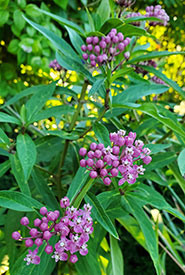Trials and tribulations of native plant gardening

Oblique streaktail on my wild nodding onion plant (Photo by Wendy Ho/NCC staff)
A few years ago when my Nature Conservancy of Canada (NCC) colleague Jaimee was still residing in Alberta, we had a fun email exchange on the topic of native plant gardening. She has since moved to Nova Scotia, where she has a new array of native plants and microclimate to work with. We decided to have a reunion over this two-part blog to see what we’ve learned as newbies to establishing native gardens.

Swamp milkweed blooming a second time this season (Photo by Wendy Ho/NCC staff)
Through trial and error with some help from the online community, I’ve learned to approach this hobby at my own pace. If my plants die prematurely in the first year, or don’t come up at all in spring, there are learning opportunities hidden in those moments. I’ve also learned a bit about myself too. I preferred to let nature take care of business and find the balance between minimal involvement and an unruly garden.
Here are some things we learned about native plant gardening:
Know your soil type

A soil test kit with one tube filled, showing one test in use and it indicates alkaline pH (Photo by Wendy Ho/NCC staff)
I have often reminisced about how my gardening journey would be smoother sailing if I had first done a soil chemistry test and understood the soil type I was working with. Some plants only thrive in a particular type of soil, but others do well in a variety of soils. Native plants are adapted to our climate, and local soils tend to require less TLC than cultivated ornamental plants, but you still need to pair the right plant with the right micro-environment.
So, to avoid conditions conducive to root rot, I learned by trial and error to plant drought and compaction-tolerant species that seem to not be bothered with their living conditions and a sporadic or infrequent watering schedule. I basically let southern Ontario summer storms take care of the watering. My picks for laid-back gardening are wild bergamot, common milkweed, Canada anemone, wild nodding onion and prairie smoke.
To fertilize or not? Sometimes, native plants thrive in nutrient poor conditions, such as many prairie plants. But others such as some meadow wildflowers need added nutrients to thrive.
Some of these plants may be considered to spread aggressively, but so far, they’ve been well contained and have not popped up in unwanted places.
Your experience will vary greatly so don’t despair and don’t compare

Bumble bee on a wild bergamot flower (Photo by Wendy Ho/NCC staff)
I’ve also found camaraderie in gardening among other colleagues, like Gayle Roodman, NCC’s manager of editorial services, who is based in Alberta. Her motivation in gardening stemmed from aspirations of being an ace gardener. She realized pretty quickly that she neither had the time, desire or knowledge to be one. Here’s where growing native plants provided the satisfaction of doing good for the environment while requiring less involvement.

Alpine forget-me-nots (Photo by Jenny Feick, CC BY-NC 4.0)
We often banter about wild bergamot, which I thought was a zero-maintenance plant and thrives despite my neglect. Gayle would disagree with my assessment as hers did not return for a third season. For her, alpine forget-me-not is a keeper for her gardening style. We’ve both found our all-star native plant for our region and that’s all that matters.
Tall native plants are better in communities of complementary native plants
I had beautiful New England asters planted from seed in an odd patch of soil by the side fence. But in the past few summers, they had grown very tall and began flopping over. I reinforced them with bamboo stakes, but they outgrew them and became taller than me (1.6 metres)! Just as I was scratching my head at this floppy situation, I stumbled upon a gardening post that talked about root competition.
Essentially, native prairie plants in their natural environment grow alongside many other species. In a landscaped environment, tall native plants that are planted with too much space have little root competition and can lead to excessive vegetation growth, which gives them a flopping tendency.
You’ll still get diseases and issues, but learn to roll with the punches
I had the false impression that growing native plants would equal beautiful plants all the time. Wrong. There are still lots of problems that can plague your plants. I’ve been learning about how to deal with powdery mildew and aster yellows that return every summer. I also learned about how some plants need to be divided once every few years to keep the patch from overcrowding. I’ve done a transplant in the previous year, and it looks like I might have to share plants with friends and the community because the wild nodding onions have been quite prolific and need another division.
Stay tuned for the next blog to see how Jaimee’s new garden has flourished this year.
Want to learn more about ways you can contribute to nature? Try these Small Acts of Conservation >


